Related Research Articles
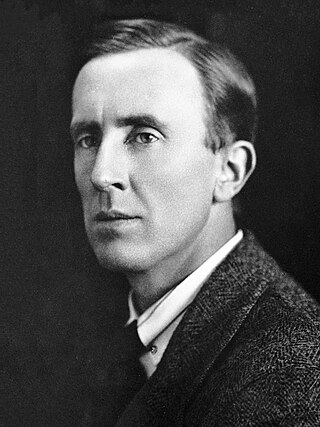
John Ronald Reuel Tolkien was an English writer and philologist. He was the author of the high fantasy works The Hobbit and The Lord of the Rings.

Christopher John Reuel Tolkien was an English and naturalised French academic editor. The son of author and academic J. R. R. Tolkien, Christopher Tolkien edited much of his father's posthumously published work, including The Silmarillion and the 12-volume series The History of Middle-Earth. Tolkien also drew the original maps for his father's The Lord of the Rings.
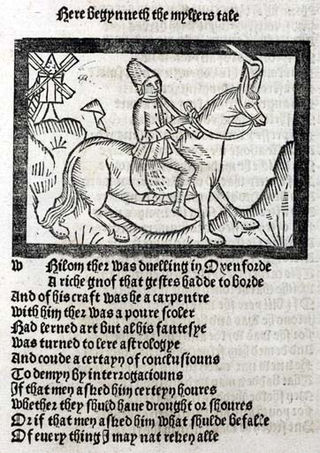
Middle English is a form of the English language that was spoken after the Norman Conquest of 1066, until the late 15th century. The English language underwent distinct variations and developments following the Old English period. Scholarly opinion varies, but Oxford University Press specifies the period when Middle English was spoken as being from 1100 to 1500. This stage of the development of the English language roughly followed the High to the Late Middle Ages.

In Christianity, an anchorite or anchoret is someone who, for religious reasons, withdraws from secular society to be able to lead an intensely prayer-orientated, ascetic, or Eucharist-focused life. Anchorites are frequently considered to be a type of hermit, but unlike hermits, they were required to take a vow of stability of place, opting for permanent enclosure in cells often attached to churches. Also unlike hermits, anchorites were subject to a religious rite of consecration that closely resembled the funeral rite, following which they would be considered dead to the world and a type of living saint. Anchorites had a certain autonomy, as they did not answer to any ecclesiastical authority apart from bishops.

Ancrene Wisse is an anonymous monastic rule for female anchoresses written in the early 13th century.
The works of J. R. R. Tolkien have generated a body of research covering many aspects of his fantasy writings. These encompass The Lord of the Rings and The Silmarillion, along with his legendarium that remained unpublished until after his death, and his constructed languages, especially the Elvish languages Quenya and Sindarin. Scholars from different disciplines have examined the linguistic and literary origins of Middle-earth, and have explored many aspects of his writings from Christianity to feminism and race.
Linguistic purism in English is the opposition to foreign influence in the English language. English has evolved with a great deal of borrowing from other languages, especially Old French, since the Norman conquest of England, and some of its native vocabulary and grammar have been supplanted by features of Latinate and Greek origin. Efforts to remove or consider the removal of foreign terms in English are often known as Anglish, a term coined by author and humorist Paul Jennings in 1966.
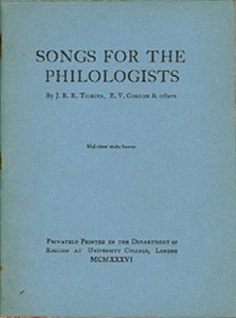
Songs for the Philologists is a collection of poems by E. V. Gordon and J. R. R. Tolkien as well as traditional songs. It is the rarest and most difficult to find Tolkien-related book. Originally a collection of typescripts compiled by Gordon in 1921–1926 for the students of the University of Leeds, it was given by A. H. Smith of University College London, a former student at Leeds, to a group of students to be printed privately in 1935 or 1936, and printed in 1936 with the impressum "Printed by G. Tillotson, A. H. Smith, B. Pattison and other members of the English Department, University College, London."

"A Secret Vice", also known as "A Hobby for The Home", is a lecture first presented by English philologist and author J. R. R. Tolkien in 1931. The lecture concerns Tolkien's relations with and view on constructed languages, in particular on artistic languages. In the talk, Tolkien discusses the human desire to make languages, and his criteria to create a good language – these include phonoaesthetics and the presence of a mythology to accompany the language. Tolkien's presentation was the first instance of him openly exhibiting his hobby of conlanging, and includes examples of several of his languages.
"Ancrene Wisse and Hali Meiðhad" is a 1929 essay by J. R. R. Tolkien on the thirteenth century Middle English treatise Ancrene Wisse and on the tract on virginity Hali Meiðhad. The essay has been called "the most perfect though not the best-known of Tolkien's academic pieces". Tolkien and Neil Ripley Ker later edited a volume of the text for the Early English Text Society.
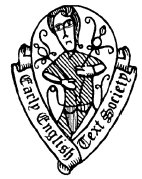
The Early English Text Society (EETS) is a text publication society founded in 1864 which is dedicated to the editing and publication of early English texts, especially those only available in manuscript. Most of its volumes contain editions of Middle English or Old English texts. It is known for being the first to print many important English manuscripts, including Cotton Nero A.x, which contains Pearl, Sir Gawain and the Green Knight, and other poems.
This is a list of all published works of the English writer and philologist J. R. R. Tolkien. Tolkien's works were published before and after his death.
The so-called Katherine Group is a group of five 13th-century Middle English texts composed by an anonymous author of the English West Midlands, in a variety of Middle English known as AB language.
South English legendaries are compilations of versified saints' lives written in southern dialects of Middle English from the late 13th to 15th centuries. At least fifty of these manuscripts survive, preserving nearly three hundred hagiographic works.
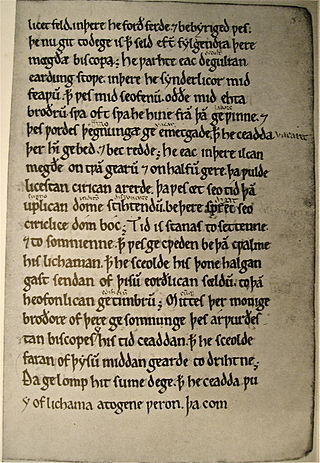
The Tremulous Hand of Worcester is the name given to a 13th-century scribe of Old English manuscripts with handwriting characterized by large, shaky, leftward leaning figures usually written in light brown ink. He is assumed to have worked in Worcester Priory, because all manuscripts identified as his work have been connected to Worcester.
The Treatise of Love is an English prose text first printed around 1493. Its printing was the work of Wynkyn de Worde, who took over William Caxton's printing business in 1491, and printed the Treatise before he began publishing under his own name in 1494. Drawing greatly on the Ancrene Wisse, the text contains religious advice addressed to an audience of aristocratic women.
The Lambeth Homilies are a collection of homilies found in a manuscript in Lambeth Palace Library, London. The collection contains seventeen sermons and is notable for being one of the latest examples of Old English, written as it was c. 1200, well into the period of Middle English.
The Wooing Group is a term coined by W. Meredith Thompson to identify the common provenance of four early Middle English prayers and meditations, written in rhythmical, alliterative prose. The particular variety of Middle English in which the group is written is AB language, a written standard of the West Midlands which also characterises the Ancrene Wisse and the Katherine Group.
A Linguistic Atlas of Early Middle English (LAEME) is a digital, corpus-driven, historical dialect resource for Early Middle English (1150–1325). LAEME combines a searchable Corpus of Tagged Texts (CTT), an Index of Sources, and dot maps showing the distribution of textual dialect features. LAEME is headed by the University of Edinburgh's Margaret Laing, and includes contributions from Roger Lass, and web-scripts by Keith Williamson, Vasilis Karaiskos and Sherrylyn Branchaw.
Mabel Katharine Day was a British scholar of medieval English. She managed the Early English Text Society from 1921 to the 1940s as assistant director. She edited and published medieval texts including contributions to A Guide for Anchoresses and Sir Gawain and the Green Knight.
References
- Corrie, Marilyn. 2006. "Middle English - Dialects and Diversity". The Oxford History of English. Ed. Lynda Mugglestone. Oxford: OUP, pp. 86-119.
- Crystal, David. 2004. The Stories of English. London: Penguin, chapter 9.
- Hall, Joseph, ed. (1920), Selections from Early Middle English, 1130-1250. 2 vols., Oxford: Clarendon Press.
- Tolkien, J.R.R., ed. (1962), The English Text of the Ancrene Riwle: Ancrene Wisse: Edited from MS. Corpus Christi College, Cambridge 402, Intro. by Ker, N.R., Oxford University Press for the Early English Text Society. (Reprinted in 2000 ISBN 0-19-722249-8).
- Tolkien, J.R.R. (1929), "Ancrene Wisse and Hali Meiðhad", Essays and Studies by Members of the English Association, 14: 104–126.